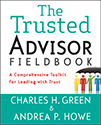This post is part of our Weekly Tips series.
The best way to get better at risk-taking is to practice risk-taking. Here are three (of six) best practices to expand your risk-taking aptitude:
- Be proactive about reducing ambiguity. For example, “Hmmmm … I’m not sure how to interpret the silence in the room.”
- Acknowledge uncomfortable situations out loud. “Wow, this is awkward …” or “I wish I had better news …” or “The timing with this is embarrassing …”
- Deliver hard news promptly and concisely. “We’re not going to make the deadline” or “We just don’t have the executive sponsorship we need” or “Jim is leaving the team.” (For best results, start with a caveat.)
Bonus: Making it Real
This week, examine your risk-taking tolerance. Here’s how.
Bring to mind a key stakeholder (e.g., client, prospect, colleague, staff member) with whom you have an exemplary trust-based relationship. In what ways is personal risk present in the relationship? How do you take risks? How does your stakeholder take risks?
Now, bring to mind a key stakeholder with whom you’d like to have an improved—or even transformed—relationship. What opportunities do you see to improve the relationship by taking more personal risk?
Learn More

- Learn about six risks you should take to build trust.
- Read about the skill of risk-taking in Chapter 9 of The Trusted Advisor Fieldbook: A Comprehensive Toolkit for Leading with Trust.
Andrea Howe
Latest posts by Andrea Howe (see all)
- Role models for healthy candor - May 27, 2025
- A small gesture (and related risk) with big trust impact (Part II) - April 1, 2025
- A small gesture (and related risk) with big trust impact (Part I) - March 3, 2025
